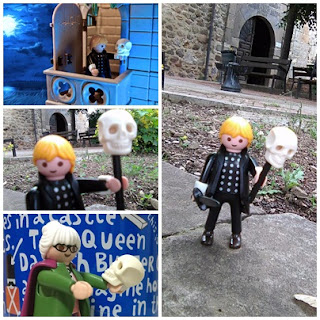Today, The Fosters and The Grandma have continued celebrating Saint George, and preparing their A2 Cambridge Exam working some aspects like reading, writing and listening.
Saint George (AD 275–281 to 23 April 303), according to legend,
was a Roman soldier of Greek origin and officer in the Guard of Roman
emperor Diocletian, who was ordered his death for failing to recant his
Christian faith. As a Christian martyr, he later became one of the most
venerated saints in Christianity and in particular the Crusades.
In hagiography, as one of the Fourteen Holy Helpers and one of the most prominent military saints, he is immortalised in the myth of Saint George and the Dragon. His memorial, Saint George's Day, is traditionally celebrated on April 23.
Numerous countries, cities, professions and organisations claim Saint George as their patron: England, Catalonia, Georgia, Malta, Armenia, Belgium, Egypt, Brazil, Bulgaria, Canada, Ethiopia, Germany, Greece, India, Italy, Lebanon, Lithuania, Montenegro, Palestine, Portugal, Russia, Serbia, Aragon, Castile and Leon, Syria and the United States.
George's parents were Christians of Greek background, his father Gerontius was a Roman army official from Cappadocia, and his mother Polychronia was a Christian and a Greek native from Lydda in the Roman province of Syria Palaestina.
Accounts differ regarding whether George was born in Cappadocia or
Syria Palaestina, but agree that he was raised at least partly in Lydda.
Some evidence links the legend back to very old Egyptian and Phoenician sources in a late antique statue of Horus fighting a dragon.
This ties the legendary George, though not necessarily the historical
George, to various ancient sources using mythological and linguistic
arguments. In Egyptian mythology, the god Setekh murdered his brother
Osiris. Horus, the son of Osiris, avenged his father's death by killing
Setekh. This iconography of the horseman with spear overcoming evil was
widespread throughout the Christian period.
As
a highly celebrated saint in both the Western and Eastern Christian
churches, Saint George is connected with a large number of patronages
throughout the world, and his iconography can be found on the flags and
coats of arms of a number of cities and countries.
Traces of the cult of St George predate the Norman Conquest,
in 9th-century liturgy used at Durham Cathedral, in a 10th-century
Anglo-Saxon martyrology, and in dedications to Saint George at
Fordington, Dorset, at Thetford, Southwark and Doncaster. He received
further impetus when the Crusaders returned from the Holy Land in the 12th century.
At the Battle of Antioch
in 1098, St George, St Demetrius and St Maurice were said to have been
seen riding alongside the crusaders, and depictions of this event can be
seen in a number of churches. King Edward III (reigned 1327–77) was known for promoting the codes of knighthood and in 1348 founded the Order of the Garter.
During his
reign, George came to be recognised as the patron saint of the English
monarchy; before this, Saint Edmund had been considered the patron saint
of England, although his veneration had waned since the time of the
Norman conquest, and his cult was partly eclipsed by that of Edward the
Confessor. Edward dedicated the chapel at Windsor Castle to the soldier
saint who represented the knightly values of chivalry which he so much
admired, and the Garter ceremony takes place there every year.
In the 16th century, Edmund Spenser included St. George, Redcross Knight, as a central figure in his epic poem The Faerie Queene. William Shakespeare firmly
placed St George within the national conscience in his play Henry V, in
which the English troops are rallied with the cry God for Harry, England and St George, and in Richard III, and King Lear.
A late 17th-century ballad also claims St. George as an English patron.
The ballad compares other mythic and historical heroes with the merit
of St. George and concludes that all are less important than St. George.
Above
the Palace of Westminster, there are six shields above each of the four
clock faces of Big Ben, twenty-four in total, all depicting the arms of
St George, representing the Flag of England, London as the capital city of England, and St. George as the patron saint of England. This symbolism is also repeated in the central lobby of the Houses of Parliament,
in an enormous mosaic created by Sir Edward John Poynter in 1869,
depicting St George and the Dragon with these arms, entitled St George for England.
Saint George, Sant Jordi in Catalan, is the patron saint of Catalonia. His cross appears in many buildings and local flags, including the one of the Catalan capital, Barcelona. The Catalan tradition usually locates the events of his legend in the town of Montblanc, near Tarragona.
By
the 15th century Catalan men used to celebrate Saint George's Day by
giving roses to women. Nowadays Saint George is not a public holiday
anymore but is a very popular celebration. Women receive roses and books
and, since the 20th century, men receive books and roses and the
celebration is also used to celebrate Catalan national identity, culture
and literature and romantic love.
One of the highest civil distinction awarded in Catalonia is the Saint George's Cross (Creu de Sant Jordi).
A people without the knowledge of their past history,
origin and culture is like a tree without roots.
Marcus Garvey

.jpg)
%20(1).jpg)

.jpg)



